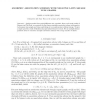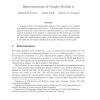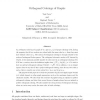12 search results - page 2 / 3 » On the number of transversals in latin squares |
JCT
2011
12 years 8 months ago
2011
Abstract. Norton and Stein associated a number with each idempotent quasigroup or diagonalized Latin square of given finite order n, showing that it is congruent mod 2 to the tria...
FFA
2006
13 years 5 months ago
2006
Applying results from partial difference sets, quadratic forms, and recent results of Brouwer and Van Dam, we construct the first known amorphic association scheme with negative La...
DM
2000
13 years 5 months ago
2000
A graph is said to be representable modulo n if its vertices can be labelled with distinct integers between 0 and n - 1 inclusive such that two vertices are adjacent if and only i...
LATIN
2004
Springer
13 years 10 months ago
2004
Springer
We consider the problem of protein folding in the HP model on the 3D square lattice. This problem is combinatorially equivalent to folding a string of 0’s and 1’s so that the s...
COMBINATORICS
1999
13 years 4 months ago
1999
An orthogonal coloring of a graph G is a pair {c1, c2} of proper colorings of G, having the property that if two vertices are colored with the same color in c1, then they must hav...



